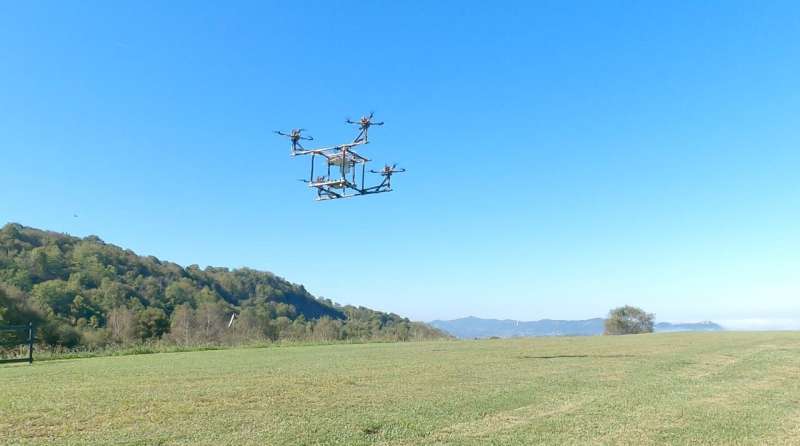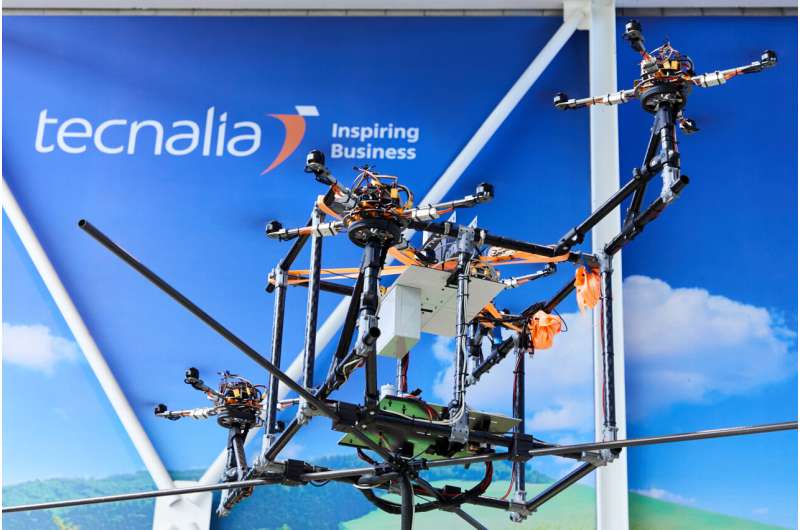August 9, 2024 feature
This article has been reviewed according to Science X's editorial process and policies. Editors have highlighted the following attributes while ensuring the content's credibility:
fact-checked
trusted source
proofread
An aerial robot that can independently control its own position and orientation

Unmanned aerial vehicles (UAVs), commonly known as drones, are now used to capture images and carry out a wide range of missions in outdoor environments. While there are now several UAV designs with different advantages and characteristics, most conventional aerial robots are underactuated, meaning that they have fewer independent actuators than their degrees of freedom (DoF).
Underactuated systems are often more cost-effective and can be controlled using simpler control strategies than overactuated systems (i.e., robots that have more independent actuators than their DoF). Nonetheless, they are often less reliable and not as capable of precisely controlling their position and orientation.
Researchers at Tecnalia's Basque Research and Technology Alliance (BRTA) in Spain recently developed a new overactuated aerial robot that can independently control the position and orientation of its main body. This robot, introduced in a paper published in Robotics and Autonomous Systems, has four quadrotors that cooperatively carry its central body.
"Our recent paper was inspired by the need to push the boundaries of UAVs beyond passive observation tasks, to help automate tasks that are currently dangerous or expensive, such as work at heights or in remote locations," Imanol Iriarte, co-author of the paper, told TechXplore. "We sought to develop a system that could actively interact with its environment, performing tasks such as load transportation, cooperative building, contact-based inspection, or maintenance of infrastructures."
The primary objective of the recent work by Iriarte and his colleagues at Tacnalia was to design an aerial robot with several actuators contributing to the generation of its thrust, which could independently control its central body's position and orientation. The robot they developed consists of a main body connected to four quadrotors via passive universal joints.

"The quadrotors cooperatively carry the main body, which allows for independent control of the main body's six degrees of freedom, enabling the robot to perform complex maneuvers and interact with its environment in a more dexterous way," Iriarte explained. "The key advantages of our system are its high control authority, its ability to take-off and land on inclined surfaces, and its thrust-vectoring capabilities."
In addition to their aerial robot, the researchers also developed an ad-hoc control algorithm that converts the requested positions and orientations of the main body into angular speed commands for the robot's 16 propellers. This algorithm also efficiently rejects external disturbances, thus further enhancing the robot's control.
"Our aerial robot can autonomously track the six degrees of freedom of its main body using only passive mechanisms, a feat that is inherently unfeasible for conventional underactuated multirotors," Iriarte said. "The practical applications of the robot could be numerous, including load transportation, cooperative building, contact-based inspection, or maintenance of infrastructures."
Iriarte and his colleagues have so far evaluated their robot in a series of tests performed both in simulation and in a real-world outdoor setting. They found that their robot could autonomously track its central body's 6 DoF, which is unattainable by conventional UAVs.
In the future, the researchers' robot could be improved further and tested in a broader range of real-world environments. Eventually, it could be used to tackle various complex missions that require high-precision control and tracking.
"In our next studies, we plan to increase the robot's level of autonomy and improve the system's performance and robustness, as well as studying variations of the architecture more suitable to specific tasks," Iriarte added.
More information: Imanol Iriarte et al, An overactuated aerial robot based on cooperative quadrotors attached through passive universal joints: Modeling, control and 6-DoF trajectory tracking, Robotics and Autonomous Systems (2024). DOI: 10.1016/j.robot.2024.104761
© 2024 Science X Network
















